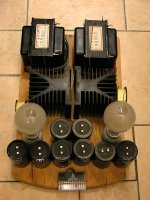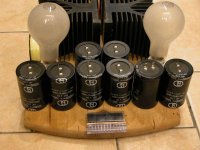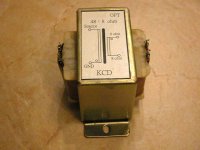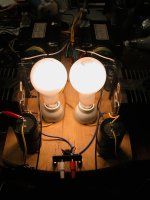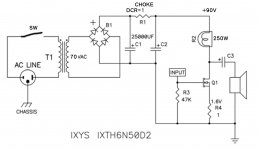Lamp microphonics are possible, although I haven't
encountered them. If you run the amp with an oscillator
up and down the frequency band, you will often encounter
some "singing" in the lamp at around 1 KHz, but it's pretty
minor.
😎
encountered them. If you run the amp with an oscillator
up and down the frequency band, you will often encounter
some "singing" in the lamp at around 1 KHz, but it's pretty
minor.
😎
More Microphonics...
I finally got back from the in-law's (or outlaws) and had a chance to delve into the microphonics problem more. I let everything power up and get to steady state and then tapped a bulb and I got a nice distorted buzz. I get this with our without music playing through the amp. I still have to do any test with a signal generator to look for the "singing" you talked about NP.
I would suggest that anyone building these position them well away from speakers and possibly dampen the bulbs in some way. That is what I am going to look into next.
Chemania
I finally got back from the in-law's (or outlaws) and had a chance to delve into the microphonics problem more. I let everything power up and get to steady state and then tapped a bulb and I got a nice distorted buzz. I get this with our without music playing through the amp. I still have to do any test with a signal generator to look for the "singing" you talked about NP.
I would suggest that anyone building these position them well away from speakers and possibly dampen the bulbs in some way. That is what I am going to look into next.
Chemania
today I found this website:
Experience Music, Inc - Eimac 75tl Amplifier
http://www.jeffreywjackson.com/amplifiers.htm
http://www.jeffreywjackson.com/speakers.htm
There you will find some cabinet inspirations for new projects
Experience Music, Inc - Eimac 75tl Amplifier
http://www.jeffreywjackson.com/amplifiers.htm
http://www.jeffreywjackson.com/speakers.htm
There you will find some cabinet inspirations for new projects
Any suggestions for getting the big electrolytics in the power supply (from mouser, digikey, etc)? Cheap is best 😀
For the 100V version, the caps have to be rated at what voltage?
For the 100V version, the caps have to be rated at what voltage?
Hi
I'd received my GB's MOSFETs today!
And Elko caps had arrived, too! They are 10000u/100V, NOS, very cheap.
Soon will start this project......
The last picture is OPT, but manufacturer told me it is rated at 1A-1.5A, so I cannot used on delite.....but maybe I can do something with LU1014!
I'd received my GB's MOSFETs today!
And Elko caps had arrived, too! They are 10000u/100V, NOS, very cheap.
Soon will start this project......
The last picture is OPT, but manufacturer told me it is rated at 1A-1.5A, so I cannot used on delite.....but maybe I can do something with LU1014!
Attachments
Lamp microphonics are possible, although I haven't
encountered them. If you run the amp with an oscillator
up and down the frequency band, you will often encounter
some "singing" in the lamp at around 1 KHz, but it's pretty
minor.
😎
Yes my bulbs whisper, too.
the first version is using 6N50D2, but no input cap.
the sound is good, but by-pass cap on output cap is necessary, a little bit bothering......
so I swapped some wires, add the OPT I mentioned, well,.....It sounds a LOT more better!
the sound is good, but by-pass cap on output cap is necessary, a little bit bothering......
so I swapped some wires, add the OPT I mentioned, well,.....It sounds a LOT more better!
Attachments
It's interesting how people often have a preference for a
transformer over an output cap. The cap measures better.
A lot better.
I have several examples of amplifiers which put transformers
to use, none of which measure spectacularly, several of which
get very high praise from listeners. What do you suppose it is?
😎
transformer over an output cap. The cap measures better.
A lot better.
I have several examples of amplifiers which put transformers
to use, none of which measure spectacularly, several of which
get very high praise from listeners. What do you suppose it is?
😎
It's interesting how people often have a preference for a
transformer over an output cap. The cap measures better.
A lot better.
I have several examples of amplifiers which put transformers
to use, none of which measure spectacularly, several of which
get very high praise from listeners. What do you suppose it is?
😎
"The Truth is out there"

Output trafo improves interaction of amp with speakers, also trafo is free from dielectric absorption effects and some other artefacts of big electrolytic caps. I believe that output cap must be formed from a number of 1000uf Elna Cerafines, plus decent shunt cap. In this way amp could sound clearer than with trafo.
It's interesting how people often have a preference for a
transformer over an output cap. The cap measures better.
A lot better.
I have several examples of amplifiers which put transformers
to use, none of which measure spectacularly, several of which
get very high praise from listeners. What do you suppose it is?
post #301: Lamp microphonics are possible, although I haven't
encountered them. If you run the amp with an oscillator
up and down the frequency band, you will often encounter
some "singing" in the lamp at around 1 KHz, but it's pretty
minor.
I think, it's certainly distortion behaviour could be therefore the reason - this is more "ear-friendly" than the distortion effects through dielectric absorbtion and other unwanted effects by bad capacitor quality.
Output transformers sometimes are very expensive, but much more cheaper than MKP-caps between 2000uF and 20000uF
datasheets about such caps you will find by post #2 about
http://www.diyaudio.com/forums/soli...ter-reference-amplifier-schematic-wanted.html
But top-class electrolytic caps in all cases cheaper than transformers, so the best compromise is the use of such electrolytic caps in combination with bypassed MKP caps between 20 and 200uF as to see about the pics about
http://www.diyaudio.com/forums/pass...itional-op-amp-ultimate-sounding-phl1230.html
The often observed "singing" by checking all kind of power amps without loudspeaker load with an oscillator is sometimes also present by the electrolytic caps, the output power devices, the transformer and some other devices. Could this be the reason for audible but not to measure differences if I will compare various brands and quality standarts of caps and resistors (and various absorber materials)? - Who knows
Last edited:
It's interesting how people often have a preference for a
transformer over an output cap. The cap measures better.
A lot better.
I have several examples of amplifiers which put transformers
to use, none of which measure spectacularly, several of which
get very high praise from listeners. What do you suppose it is?
😎
With the output capacitor ,
I may be completely wrong about the following ,but, some extended listening and experience tells me that somehow the speaker likes to be connected with its negative pole to ground . That of course remembering, if we do that ,to find an audio source where the polarity can be inverted .
With the transformer I am more incline to think that the distorsion goes a little toward the 3rd armonic . Can it be ?
Just to be clear. To preserve "proper absolute phase" requires that the speaker "+" be connected to ground for the capacitive coupled circuit. Correct?
Just to be clear. To preserve "proper absolute phase" requires that the speaker "+" be connected to ground for the capacitive coupled circuit. Correct?
cap or not cap - that's completely irrelevant .
amp itself is inverting , or non-inverting ..... output cap-less,or not
Umm..., I thought that the wiring of the OPT could affect the polarity of the speaker connection. Back to the books for me.
Umm..., I thought that the wiring of the OPT could affect the polarity of the speaker connection. Back to the books for me.
well - you didn't mention OPT in post #317
- Home
- Amplifiers
- Pass Labs
- Pass "DeLite" Amp from BAF
